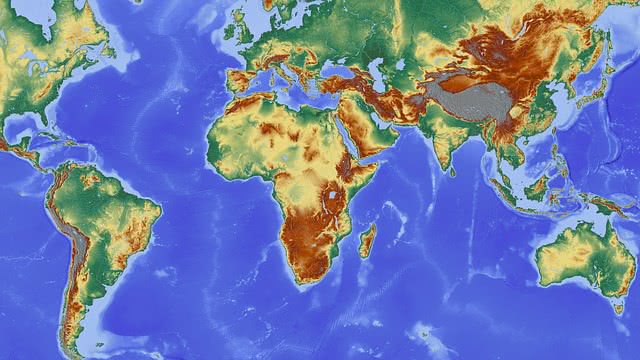When it comes to maps there are several different types. Each map can show different information. Most maps will include a compass rose which simply indicates which way is North, South, East, and West. In addition, they can also include a scale that will allow you to estimate distances shown on the map. Below there is a list of some different types of maps and what information they show:
- Topographic Maps: These maps include contour lines (a line on a map joining points of equal height above or below sea level) to show the shape and elevation of an area. Lines that are closer together will indicate steep terrain while lines that are further apart indicate flat terrain. For example a topographic map showing the Big Island of Hawaii would have contour lines that are close together near the steep, high elevation mountains of Mauna Loa and Kilauea. By contrast, the low elevation, flat coastal areas show contour lines that are spread apart.

- Climate Maps: These maps give general information about the climate and precipitation (rain/snow) in a particular region. Cartographers or mapmakers use colors to indicate different climate or precipitation zones. A climate map for Australia for example uses colors to show differences between the temperate area of Victoria and desert region in the center of the continent.
- Physical Maps: These maps illustrate the physical features of an area such as mountains, rivers, and lakes. The water is typically shown in blue, green is usually used at lower elevations, and orange/brown indicate higher elevations. Colors are used to indicate relief (differences in land elevations). An example of a physical map is one showing the state of Hawaii. Low elevation coastal regions are shown in dark green, while the higher elevations transition from orange to dark brown. Rivers are shown in blue.
- Economic or Resource Maps: These maps feature types of natural resources or economic activity that dominates and area. People who draw maps use symbols to illustrate the locations of a particular natural resource or economic activity. For example, oranges on a map of Florida tell you that oranges are grown there. For example an economic activity map for Brazil can use colors to show different agricultural products of given areas, letters for natural resources and symbols for different industries.
- Political Maps: These maps do not show physical features but instead indicate state and national boundaries, capital cities, and major cities. A capital city is typically marked as a star within a circle. A common type of political map would be one showing the 50 U.S. states and their borders along with the United States’ north and south international borders.
- Road Maps: These maps show mostly major and some minor highways. In addition they show roads, airports, railroad tracks, cities, and other points of interest in a particular area. Perhaps one of the mostly commonly used maps-people tend to use road maps to plan trips and for driving directions. Major highways on a road map are generally red and larger than other roads, while minor roads are a lighter color and a narrower line. A road map of San Francisco, California for example would show the major highways as a wide red line and other large roads as a lighter red with minor streets as gray.